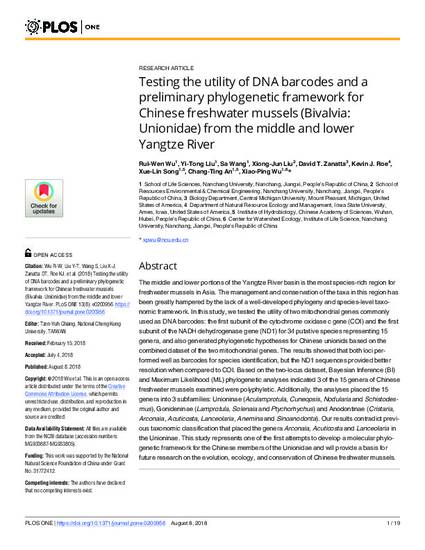
The middle and lower portions of the Yangtze River basin is the most species-rich region for freshwater mussels in Asia. The management and conservation of the taxa in this region has been greatly hampered by the lack of a well-developed phylogeny and species-level taxonomic framework. In this study, we tested the utility of two mitochondrial genes commonly used as DNA barcodes: the first subunit of the cytochrome oxidase c gene (COI) and the first subunit of the NADH dehydrogenase gene (ND1) for 34 putative species representing 15 genera, and also generated phylogenetic hypotheses for Chinese unionids based on the combined dataset of the two mitochondrial genes. The results showed that both loci performed well as barcodes for species identification, but the ND1 sequences provided better resolution when compared to COI. Based on the two-locus dataset, Bayesian Inference (BI) and Maximum Likelihood (ML) phylogenetic analyses indicated 3 of the 15 genera of Chinese freshwater mussels examined were polyphyletic. Additionally, the analyses placed the 15 genera into 3 subfamilies: Unioninae (Aculamprotula, Cuneopsis, Nodularia and Schistodesmus), Gonideninae (Lamprotula, Solenaia and Ptychorhychus) and Anodontinae (Cristaria, Arconaia, Acuticosta, Lanceolaria, Anemina and Sinoanodonta). Our results contradict previous taxonomic classification that placed the genera Arconaia, Acuticosta and Lanceolaria in the Unioninae. This study represents one of the first attempts to develop a molecular phylogenetic framework for the Chinese members of the Unionidae and will provide a basis for future research on the evolution, ecology, and conservation of Chinese freshwater mussels.
Available at: http://works.bepress.com/kevin_roe/19/

This article is published as Wu, Rui-Wen, Yi-Tong Liu, Sa Wang, Xiong-Jun Liu, David T. Zanatta, Kevin J. Roe, Xue-Lin Song, Chang-Ting An, and Xiao-Ping Wu. "Testing the utility of DNA barcodes and a preliminary phylogenetic framework for Chinese freshwater mussels (Bivalvia: Unionidae) from the middle and lower Yangtze River." PloS one 13, no. 8 (2018): e0200956. doi: 10.1371/journal.pone.0200956.